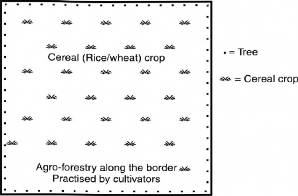Agro-Forestry
Agro-forestry is a sustainable management for land that increases overall production, combines agricultural crops, tree crops, forest plants and animals simultaneously and applies management practices that are compatible with cultural patterns of local population,
Agro-forestry is a type of social forestry in which individual farmer undertakes tree-farming and grows fodder plants, grasses and legumes on his own land. In agio-forestry, trees (forest) are considered as a crop and they (trees) become a part of crop combinations.
Agro-Forestry as a crop
Absentee landlords

Fig. 5.4 Patterns of Agro-Forestry
There is an increasing number of farmers who plant trees either along the boundaries or in the whole field/farm as a crop (Fig. 5.4). In fact, in the Northern Plains of India, trees are planted by most of the farmers irrespective of the size of their holdings, but the large farmers and absentee landlords pul part of their holdings or total agriculture area under tree crops.
Under agro-forestry, a farmer generally uses his degraded or useful land to plant trees for domestic use or commercial use. Such land may be his own or obtained on lease under social forestry programme.
Agro-forestry involves both the big and the small farmers. It fetches additional income to farmers, improves their income and thereby, their standard of living, and provide them employment during lean agricultural seasons. These trees are normally harvested after 6 to 10 years from the date of plantation, depending on the needs and requirements of the farmer. The main advantages of agro-forestry are:
(i) The absentee landlords go for agro-forestry to retain title of the land and to increase their income.
(ii) To manage the agricultural land even without the availability of family labour.
(iii) To ensure better land use.
(iv) To generate employment.
(v) To conserve soil moisture.
(vi) To meet the needs of fuel-wood, fodder and timber.
(vii) To protect the arable land from winds and water erosion.
Despite numerous material and geo-climatic benefits, agro-forestry has some adverse effects on agricultural land. Some of its shortcomings are given below:
(i) The market-oriented trees are preferred which damage the ecosystem. Instead of poplar and eucalyptus, the farmers should go for the plantation of Neem, Mahua, Karanj, Arjun, and acacia.
(ii) fuelwood and fodder trees are generally neglected.
(iii) The exotic varieties planted by the farmers in the form of agro-forestry are soil-moisture and water exhaustive. Consequently, the underground water table is adversely affected.
(iv) The land under agro-forestry becomes unproductive as the roots of trees become so dense that their digging and removal to bring the land under cultivation becomes very difficult unless heavy investment is made in the digging and removing of roots.
(v) In the fields along which trees have been planted, the productivity per unit area decreases, as at least in about two metres from the trees the moisture content in the soil is significantly reduced.
(vi) The trees become the habitat of many pests and diseases, adversely affecting the crops.
(vii) Unscientific method of spacing of trees, reduces the growth and mass of the trees.
In brief, Agro-forestry is a system of agricultural land utilisation which not only provides fuelwood, fodder, and grasses, but helps in the promotion of forests and their conservation. The Indian Council of Agricultural Research and the Forestry Department jointly undertake agro-forestry research in order to develop suitable systems of land management which involves integration of silviculture, with horticulture, agriculture and animal husbandry. Agro-forestry thus integrates agri-silviculture, silvi-pastoral system, and medicinal plants culture. Under agro-forestry, a farmer generally uses his degraded or useful land to plant trees for his domestic use or for commercial use.
Agro-forestry has become very popular in Andhra Pradesh, Bihar, Gujarat, Haryana, Karnataka, Kerala, Punjab, Rajasthan, Uttarakhand, and Uttar Pradesh. The main species of trees planted by farmers in their fields are eucalyptus, poplar and casuarinas. The wood of these forests is used mainly for fuel-wood, plywood, paper and pulp manufacturing, and match industries.
Agro-forestry has benefited the big farmers more than the marginal and small farmers. Many of the absentee land-lords plant commercial trees in their agricultural land-holdings to save their land from dispossession. Thus, the agricultural labourers are thrown out of employment. The diversion of good agricultural land from cereal and commercial crops may create the problem of scarcity of food stuffs and industrial raw material. The programme, therefore, needs a new strategy and reorientation to achieve its real objectives.
